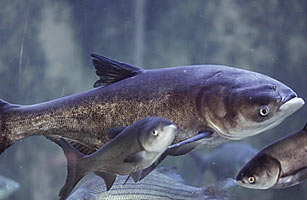
There are illegal immigrants on the loose in the Midwest. Originally hailing from Asia, they’re about 3 ft. long and weigh up to 100 lb. , and are known to resist capture. Once they establish residency, they can eat you out of house and home.
They’re called Asian carp, and they emigrated to the lower reaches of the Mississippi River in the 1970s. Now they’re knocking on the door of the Great Lakes, threatening to destroy one of the most valuable aquatic regions in the U.S., unless the often fractious Great Lakes states manage to pull together and keep them out. The situation is so serious that the White House convened an “Asian carp summit” on Monday to work out a defense plan. “If the carp invade the Great Lakes, it will change them forever,” says Jennifer Nalbone, director of invasive species and navigation for the NGO Great Lakes United. The Army Corps of Engineers put an electric barrier in the canal to prevent the carp from infiltrating Lake Michigan, but it may not have been enough — although no live fish have been found yet, last month a team of scientists discovered Asian carp DNA in Lake Michigan. “That’s enough to show that they’re likely making their way into the lakes,” says Lindsay Chadderton, director of TNC’s Great Lakes Aquatic Invasive Species program.
Scientists don’t know how large the Asian carp population would need to get before it becomes self-sustaining and morphs from nuisance into true threat. And some doubt the fish will ever make it into the lakes, given their need to spawn in long, fast-flowing rivers like the Illinois. “It might be 20 to 25 years before they really establish themselves,” says Duane Chapman, a research fish biologist with the U.S. Geological Survey. “We don’t know for sure that we’ll have any problems to speak of.”
Maybe, but that’s not how the governors of Michigan and Wisconsin are treating the problem. They want the locks of the Chicago canal to be shut down immediately, to prevent the carp from ever gaining a finhold in the Great Lakes. But Illinois lawmakers argue that closing the canal would disrupt hundreds of millions of dollars’ worth of shipping. A coalition of six Great Lakes states and the Canadian province of Ontario even sought an injunction last month from the Supreme Court to force an immediate shutdown of the canal; the court declined to issue the ruling but will hear briefs on the subject later this month.
The White House has taken action as well. On Monday, federal officials announced $78.5 million in funding to prevent the spread of Asian carp; plans include building new barriers between the Chicago canal and the Des Plaines River. “We see the threat and potential impact of the Asian carp establishing themselves in the Great Lakes,” says Nancy Sutley, chair of the White House Council on Environmental Quality. “We believe we have the chance to work together to prevent economic and environmental damage before it occurs.”
That’s an ideal plan, since it’s much easier to prevent invasive species from infiltrating a new home than it is to eradicate them after the fact. And any plague of foreign species will likely become harder to quash because of global warming, as nonnative plants and animals are often better able to adjust to changing climates than indigenous species, according to a study published last week in the journal PLoS ONE. “We have to recognize that we are the ones changing the natural world, and we have an obligation to do it responsibly,” says TNC’s Lowenstein. “Not just for the planet, but for our own sake.”
If the preventive efforts don’t work, you might want to put on a helmet the next time you go waterskiing on Lake Michigan.
See TIME’s Pictures of the Week.
Download TIME’s iPhone and BlackBerry applications.